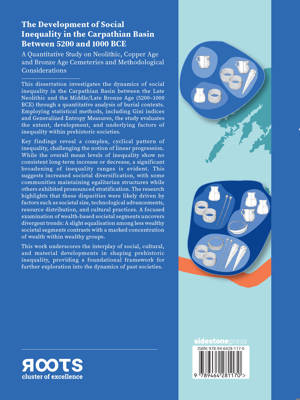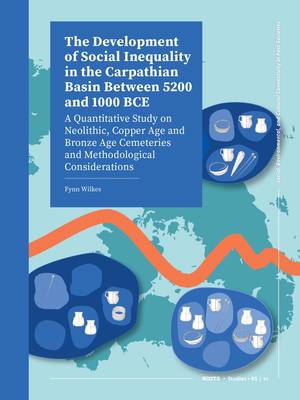
Je cadeautjes zeker op tijd in huis hebben voor de feestdagen? Kom langs in onze winkels en vind het perfecte geschenk!
- Afhalen na 1 uur in een winkel met voorraad
- Gratis thuislevering in België vanaf € 30
- Ruim aanbod met 7 miljoen producten
Je cadeautjes zeker op tijd in huis hebben voor de feestdagen? Kom langs in onze winkels en vind het perfecte geschenk!
- Afhalen na 1 uur in een winkel met voorraad
- Gratis thuislevering in België vanaf € 30
- Ruim aanbod met 7 miljoen producten
Zoeken


The Development of Social Inequality in the Carpathian Basin Between 5200 and 1000 Bce
A Quantitative Study on Neolithic, Copper Age and Bronze Age Cemeteries and Methodological Considerations
Fynn Wilkes
€ 80,00
+ 160 punten
Uitvoering
Omschrijving
This dissertation investigates the dynamics of social inequality in the Carpathian Basin between the Late Neolithic and the Middle/Late Bronze Age (5200-1000 BCE) through a quantitative analysis of burial contexts. Employing statistical methods, including Gini indices and Generalized Entropy Measures, the study evaluates the extent, development, and underlying factors of inequality within prehistoric societies.
Key findings reveal a complex, cyclical pattern of inequality, challenging the notion of linear progression. While the overall mean levels of inequality show no consistent long-term increase or decrease, a significant broadening of inequality ranges is evident. This suggests increased societal diversification, with some communities maintaining egalitarian structures while others exhibited pronounced stratification. The research highlights that these disparities were likely driven by factors such as societal size, technological advancements, resource distribution, and cultural practices. A focused examination of wealth-based societal segments uncovers divergent trends: A slight equalisation among less wealthy societal segments contrasts with a marked concentration of wealth within wealthy groups.
This work underscores the interplay of social, cultural, and material developments in shaping prehistoric inequality, providing a foundational framework for further exploration into the dynamics of past societies.
Key findings reveal a complex, cyclical pattern of inequality, challenging the notion of linear progression. While the overall mean levels of inequality show no consistent long-term increase or decrease, a significant broadening of inequality ranges is evident. This suggests increased societal diversification, with some communities maintaining egalitarian structures while others exhibited pronounced stratification. The research highlights that these disparities were likely driven by factors such as societal size, technological advancements, resource distribution, and cultural practices. A focused examination of wealth-based societal segments uncovers divergent trends: A slight equalisation among less wealthy societal segments contrasts with a marked concentration of wealth within wealthy groups.
This work underscores the interplay of social, cultural, and material developments in shaping prehistoric inequality, providing a foundational framework for further exploration into the dynamics of past societies.
Specificaties
Betrokkenen
- Auteur(s):
- Uitgeverij:
Inhoud
- Aantal bladzijden:
- 200
- Taal:
- Engels
- Reeks:
Eigenschappen
- Productcode (EAN):
- 9789464281187
- Verschijningsdatum:
- 25/03/2026
- Uitvoering:
- Hardcover
- Formaat:
- Genaaid
- Afmetingen:
- 210 mm x 279 mm

Alleen bij Standaard Boekhandel
+ 160 punten op je klantenkaart van Standaard Boekhandel
Beoordelingen
We publiceren alleen reviews die voldoen aan de voorwaarden voor reviews. Bekijk onze voorwaarden voor reviews.










